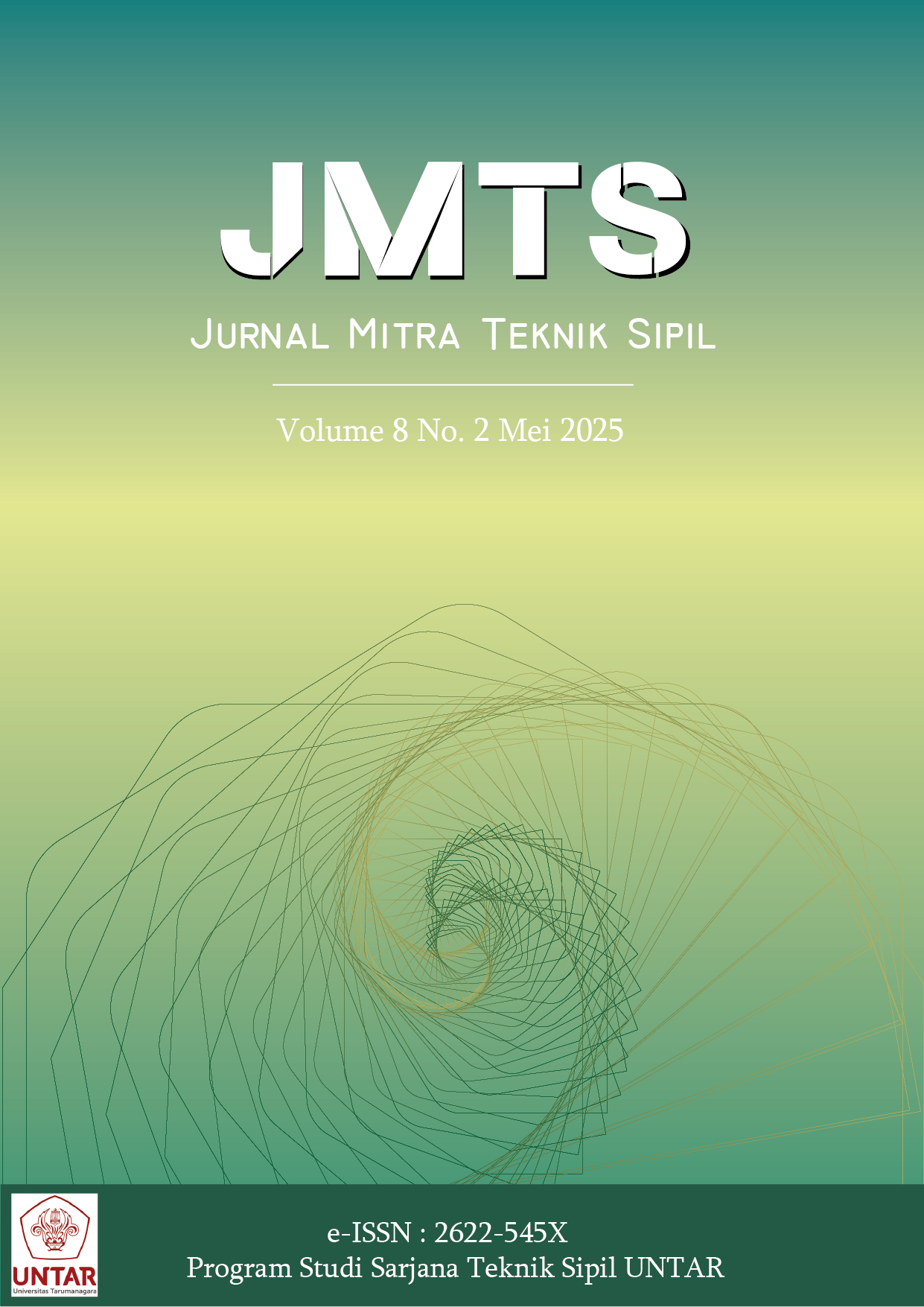ANALISIS KOMPARATIF PEMAKAIAN TWO-WAY SLAB DAN FLAT SLAB TERHADAP KINERJA SEISMIK GEDUNG “LP”
Main Article Content
Abstract
Indonesia is located in a seismically active region due to the presence of the Eurasian Plate and the Indo-Australian Plate. This means that buildings and non-building structures must be designed to withstand seismic forces. One of the critical elements in resisting earthquakes in a building is the floor slab. In addition to resisting seismic forces, the floor slab also serves as a walking and activity area for people. There are several types of floor slab construction, for example flat slab and two-way slab. When considering which type of floor slab construction to use in a building, a seismic performance analysis of the slabs is necessary to evaluate their effectiveness under gravitational loads and lateral forces. This study examines seismic performance indicators such as base shear, story shear, story displacement, and story drift that occur in each type of floor slab. The dimensions and specifications of the slabs used will be adjusted according to minimal requirements. The seismic analysis is conducted in three dimensions using response spectrum analysis. Based on the analysis results, it can be concluded that two-way slabs exhibit higher seismic resistance compared to flat slabs, as they result in greater base shear, story shear, story displacement, and story drift. Consequently, the design of buildings with two-way slabs will be safer against larger seismic loads than those with flat slabs.
Abstrak
Indonesia berada pada daerah rawan bencana gempa karena dilewati oleh lempeng Eurasia dan lempeng Indo-Australia. Hal ini berarti bangunan gedung maupun non gedung hraus dirancang menahan gaya gempa. Salah satu elemen yang membantu menyalurkan beban lateral gempa adalah pelat lantai. Selain itu, pelat lantai juga berfungsi sebagai tempat berpijak dan beraktivitas bagi manusia. Terdapat beberapa jenis konstruksi pelat lantai, contohnya adalah flat slab dan two-way slab. Dalam mempertimbangkan jenis konstruksi pelat lantai yang akan digunakan pada bangunan, dibutuhkan analisis kinerja seismik dari pelat yang dapat bekerja dan seberapa optimal mereka saat dibebani gravitasi dan gaya lateral. Penelitian ini mengkaji kinerja seismik seperti base shear, story shear, story displacement, dan story drift yang terjadi pada masing-masing jenis pelat lantai. Dimensi dan spesifikasi pelat yang digunakan akan disesuaikan dengan kebutuhan minimal. Analisis gempa dilakukan secara tiga dimensi menggunakan analisis respons spektrum. Berdasarkan hasil analisis dapat disimpulkan bahwa two-way slab memiliki ketahanan seismik yang lebih tinggi dibandingkan dengan flat slab karena menghasilkan base shear, story shear, story displacement, dan story drift yang lebih besar. Hal ini mengakibatkan desain dari bangunan konstruksi two-way slab akan lebih aman terhadap beban gempa yang lebih besar dibandingkan dengan flat slab.
Article Details

This work is licensed under a Creative Commons Attribution-NonCommercial-ShareAlike 4.0 International License.
This work is licensed under Jurnal Mitra Teknik Sipil (JMTS) Creative Commons Attribution-ShareAlike 4.0 International License.References
Badan Standarisasi Nasional. (2019). Persyaratan beton struktural untuk bangunan gedung dan penjelasan. http://sispk.bsn.go.id/SNI/DaftarList
Badan Standarisasi Nasional. (2019). Tata cara perencanaan ketahanan gempa untuk struktur bangunan gedung dan non gedung. http://sispk.bsn.go.id/SNI/DaftarList
Borkar, S., Dabhekar, K., Khedikar, I., & Jaju, S. (2021). Analysis of flat slab structures in comparison with conventional slab structures. IOP Conference Series: Earth and Environmental Science, 822(1), 012049.
Girish, N., & Lingeshwaran, N. (2018). A comparative study of flat slabs using different shear reinforcement parameters. International Journal of Engineering & Technology, 7(2.20), 321-325.
Hulke, P., & Solanke, S. S. (2023). Comparative study of different types of slab for same structural condition. IOP Conference Series: Earth and Environmental Science, 1193(1), 012001.
Ivan, L., & Leo, E. (2019). Analisis Dinamik Perilaku Gedung Dengan Ketidakberaturan Massa Pada Masing-Masing Tingkat Terhadap Beban Gempa. Jurnal Mitra Teknik Sipil, 2(3), 245-254.
Rupidara, Y. A., Cornelis, R., & Sir, T. M. (2022). Analisis perbandingan kinerja seismik dari struktur gedung dengan pelat konvensional, waffle slab, dan flat slab. Jurnal Forum Teknik Sipil, 2(1), 80-91.
Tavio, & Wijaya, U. (2018). Desain rekayasa gempa berbasis kinerja edisi kedua (performance based design) dilengkapi contoh dan aplikasi program bantu ETABS. Penerbit ANDI.
Tunç, G., Azizi, A. B., & Tanfener, T. (2023). Effects of slab types on the seismic behavior and construction cost of RC buildings. Journal of Polytechnic, 26(2), 553-567.
Violeta, I. (2024). Analisa pengaruh variasi bentuk dan konfigurasi kolom terhadap periode getar struktur. Jurnal Teknologi Infrastruktur, 3(1), 1-11.



